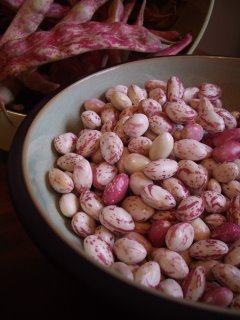Browsing through the produce stalls of Ottawa’s Byward Market this past weekend, I happened upon a curious thing. Nestled between the stout egg-shaped Asian eggplants squatting in their baskets (one of which I bought) and the baby carrots standing at attention on their shelf, there sat the beans, cock-eyed and carefree. Not just any beans, mind you. These were extraordinary maroon and cream swirled Romano Beans (actually Cranberry Beans, I later discovered).
I hummed. I hawed. What do I know about Romano Beans? What could I possibly do with them? Would they end up a sorry, forgotten mess in the bottom of the crisper at the end of the week? I considered the 40-minute walk home ahead and the bags filled with peaches, strawberries and blueberries, among other items, already weighing down my arms. I contemplated the clouds and the risk of rain, my lack of umbrella and the fact that I’d just used my last bus ticket.
And then I bought them anyways.
At $2 a pop, it was a small price to pay for a culinary adventure, I reasoned.
 Just the other night, we shelled our cranberry marvels to reveal gorgeous maroon and cream speckled beans with the occasional solid cream or maroon aberration. Almost too good to eat, but not quite. (Note: Enjoy the colour while it lasts. The boiling water sucks the fun right out, leaving them a dull shade of tan.)
Just the other night, we shelled our cranberry marvels to reveal gorgeous maroon and cream speckled beans with the occasional solid cream or maroon aberration. Almost too good to eat, but not quite. (Note: Enjoy the colour while it lasts. The boiling water sucks the fun right out, leaving them a dull shade of tan.)
After a leisurely 20-minute dip in a boiling bath, the beans acquired a creamy texture and rich flavour (like mashed potatoes or the yolk of a hardboiled egg, depending on who you ask in this household). Tossed with fresh tomatoes, chopped basil, olive oil, salt, pepper and garlic that your friends bought you at the Garlic Festival that you mean to go to every year and somehow always manage to miss, the beans made a surprisingly tasty topping for our spaghetti. Add a slice of your favourite sourdough bread spread with salted butter and you’re really set.
And you thought I only made dessert.Labels: Savoury bites
 Just the other night, we shelled our cranberry marvels to reveal gorgeous maroon and cream speckled beans with the occasional solid cream or maroon aberration. Almost too good to eat, but not quite. (Note: Enjoy the colour while it lasts. The boiling water sucks the fun right out, leaving them a dull shade of tan.)
Just the other night, we shelled our cranberry marvels to reveal gorgeous maroon and cream speckled beans with the occasional solid cream or maroon aberration. Almost too good to eat, but not quite. (Note: Enjoy the colour while it lasts. The boiling water sucks the fun right out, leaving them a dull shade of tan.)